Bioanalytics
Life Science
Solutions.
We are the distributor of Bio-analysis Instruments of Berthold Technologies in France
Enhance your lab’s performance with bio-analysis solutions from Berthold Technologies! As the official distributor of this global technology leader in life sciences instrumentation, we provide a comprehensive range of bioanalytical solutions made in Germany—ensuring precision, reliability, and cutting-edge innovation.
From routine testing to advanced processes, we offer the tools to elevate your lab:
Microplate readers
Tristar 3
Simplicity and performance for all your microplate assays
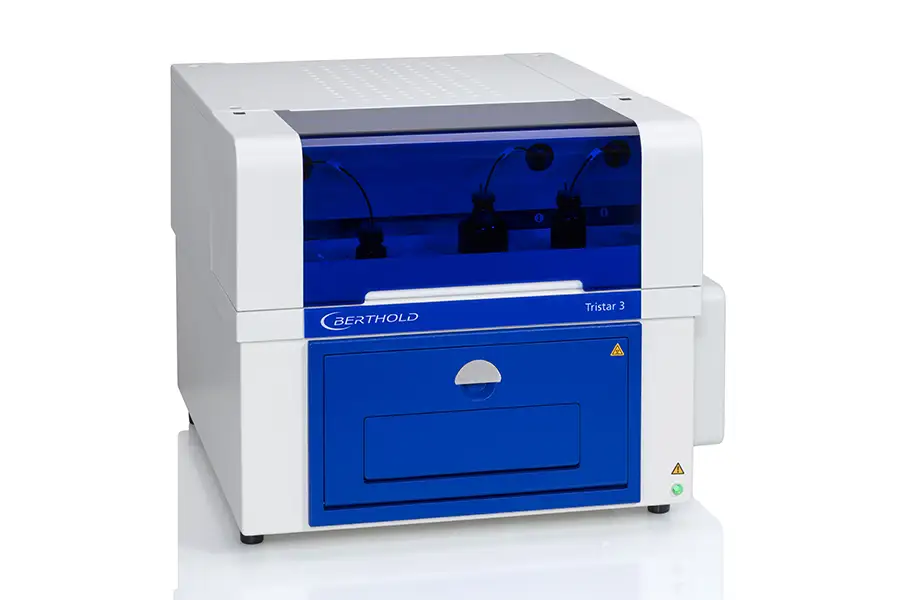
Description
The Tristar 3 is a user-friendly, scalable, and affordable multimode microplate reader designed to meet the needs of modern laboratories, regardless of their level of expertise.
Exclusive to Berthold Technologies: it features the ONE-4-ALL optical technology, ensuring optimal performance in absorbance, fluorescence, and luminescence – with no compromises.
Enhanced performance across a wide spectral range: Tristar 3 covers a broad wavelength range, from UV to near-infrared. It is suitable for a wide variety of assays, from nucleic acid quantification to the analysis of far-red fluorophores.
Scalable and ready to use: All Tristar 3 models come preconfigured to support BRET and NanoBRET™ assays, with unmatched luminescence sensitivity and high-quality filters. Just add the appropriate kit for your specific protocol and get started.
A reliable tool for your research: With Tristar 3, you benefit from Berthold Technologies quality in an easy-to-use format, while remaining scalable for your future needs.
Applications
Thanks to its flexibility, Tristar 3 supports a wide range of protocols and analyses while remaining easy to use:
- Ultra-sensitive luminescence: ideal for low-signal applications
- BRET, BRET2 and NanoBRET™: efficient detection
- UV/VIS absorbance: perfect for DNA quantification and other optical assays
- Fluorescence: suitable for standard tests as well as FRET for molecular interaction studies
- FRET: for high-precision protein–protein interaction assays
Tristar 5
High-Performance Multimode Microplate Reade
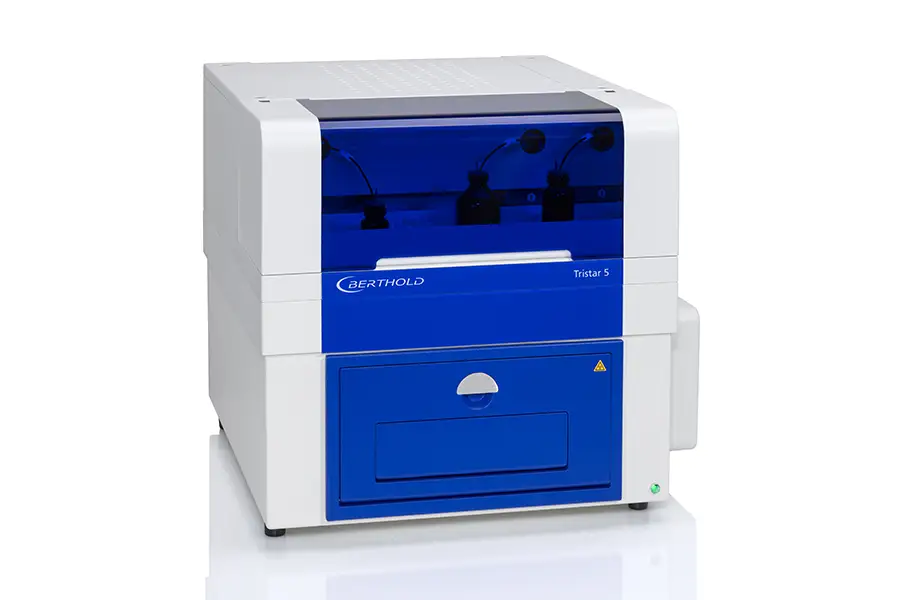
Description
The Tristar 5 is a modular and ultra-flexible multimode microplate reader designed to deliver optimal sensitivity in any experimental situation. It integrates both filters and independent monochromators, selectable by the user, for both excitation and emission. This unique configuration ensures full compatibility with a wide range of applications, even the most complex ones.
Thanks to its ONE-4-ALL optical system, each detection mode – absorbance, fluorescence, luminescence – is executed with the highest precision, without compromise. The system is also scalable and can be equipped with the optional JET rapid injection technology, enabling fast, precise, and cell-friendly dispensing, ideal for kinetic assays
The Tristar 5 covers a wide spectral range, from UV to near-infrared, and allows top or bottom reading. Bottom reading, optimized via software, is especially suited for cell-based assays on adherent cells, ensuring an excellent signal-to-noise ratio.
Applications
The Tristar 5 is designed to adapt to your current and future needs, with broad compatibility for the main detection methods used in laboratories:
- UV/VIS Absorbance: for quantification of nucleic acids, proteins, etc.
- Fluorescence: including FRET for studying molecular interactions
- Luminescence: with high-sensitivity detection for BRET, BRET2, and NanoBRET™ assays
- Time-Resolved Fluorescence (TRF): ideal for reducing background noise
- TR-FRET / HTRF®: for highly sensitive homogeneous assays
- Fluorescence Polarization (FP): for binding studies
- AlphaScreen® / LanthaScreen®: for complex no-wash assays
- Kinetic readings with JET injectors (optional): for real-time reaction monitoring
Centro
Ultra-Sensitive Microplate Luminometer
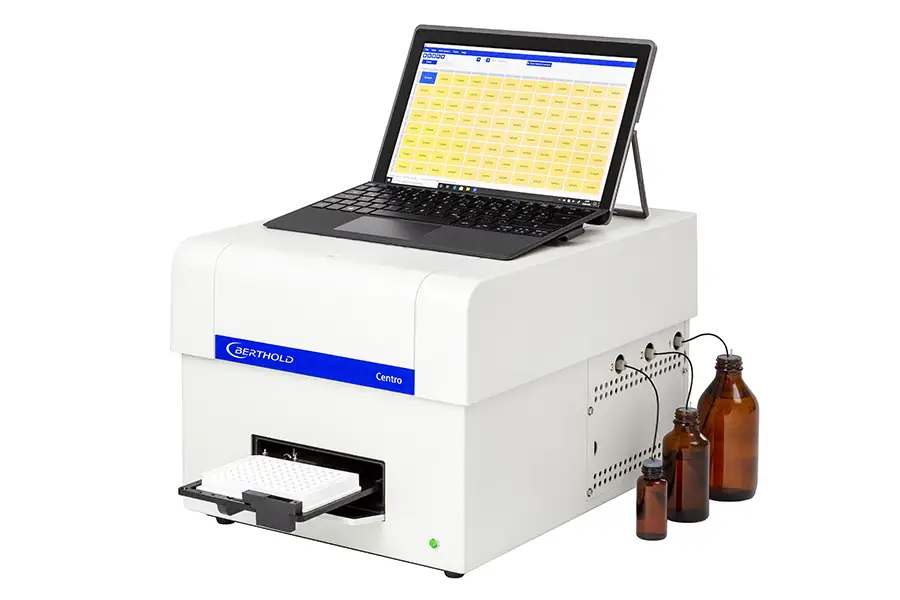
Description
The Centro is a high-performance microplate luminometer designed for Glow and Flash luminescence measurements with outstanding reliability and precision. Robust and user-friendly, it can be equipped with up to three high-performance injectors, enabling rapid kinetics or immediate trigger reactions.
The Centro is the most sensitive microplate luminometer on the market. It detects extremely low amounts of analytes — down to less than 1.8 attomoles (amol) of ATP per well. This exceptional sensitivity makes it the ideal tool for low-signal assays, without compromising on reproducibility.
- Low-noise photon-counting photomultiplier (PMT): ensures an excellent signal-to-noise ratio and high signal stability
- Optional sandwich heating: reduces evaporation and provides optimal thermal control for long-duration studies
- Programmable shaking with 3 modes: variable amplitude and speed for homogeneous sample distribution — ideal for long-term kinetics
- High-precision reagent injection: up to 3 independent JET injectors with outstanding precision (<2%)
- Built-in robotic compatibility: integration module simplifies use in automated laboratory workflows
- Adaptable to specific applications: including Aliivibrio fischeri detection or acridinium ester assays
Applications
The Centro is perfectly suited for a wide range of luminescence applications, particularly in the fields of cell biology, molecular biology, and immunology:
- Reporter gene assays (e.g., luciferase): for gene expression analysis
- ATP detection: for highly sensitive cell viability testing
- Intracellular calcium monitoring using aequorin: for cellular signaling studies
- Luminescent immunoassays (LIA, ILMA): for rapid and sensitive detection of antigens or antibodies
- DNA probe assays: for nucleic acid detection via luminescent hybridization
- SNP analysis: for precision molecular genetics
- CALUX® assays: for detection of hormonal or toxic compounds via cellular receptor activation
Elisa pollo
Apollo ELISA Reader: Fast and Reliable Performance for Your Absorbance Analyses
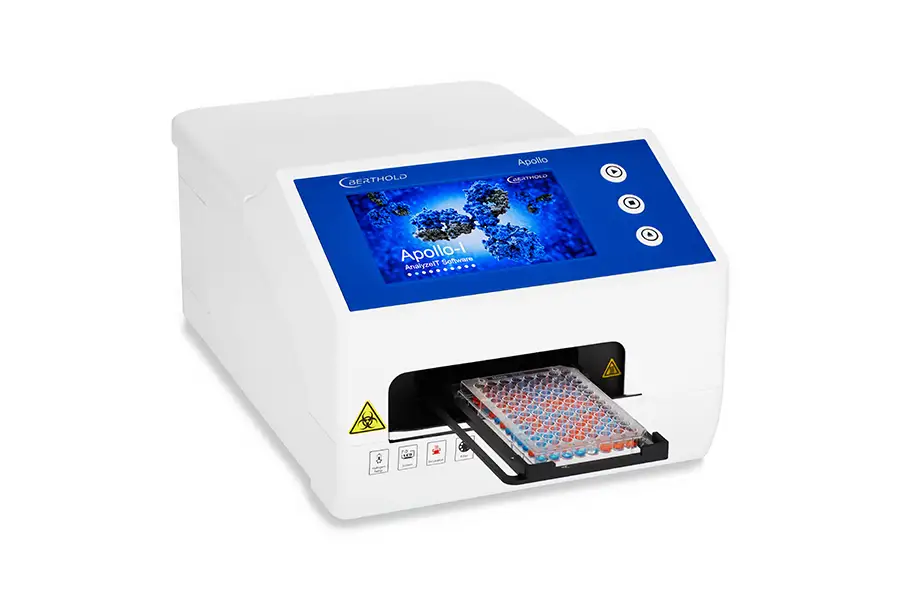
Description
The Apollo ELISA reader is designed for laboratories seeking a simple, fast, and accurate system for microplate absorbance measurements. Ideal for both routine applications and research, it combines reading speed, data accuracy, and ease of use—all in a standalone format.
- Fast microplate reading: full 96-well plate readout in just 6 seconds (fast mode)
- Standalone operation: thanks to a 7-inch color touchscreen, no computer connection is required
- Extended spectral range: from 340 to 750 nm, compatible with a wide variety of colorimetric assays
- High measurement accuracy: ±1% or ±0.005 OD (from 0 to 3 OD), ensuring optimal data reliability
- Wide dynamic range: up to 4.0 OD, covering standard and high-concentration assay needs
- Integrated shaker: with selectable speed for uniform sample mixing
- Customizable filters: pability to add filters for specific assay requirements
- Temperature control (Apollo-I model): incubation up to 50°C, ideal for temperature-sensitive assays
Applications
The Apollo ELISA Reader supports a wide range of absorbance-based applications:
- DELISA assays and other enzyme-linked immunoassays
- Reporter gene assays (e.g., β-galactosidase, alkaline phosphatase)
- Protein quantification using Lowry and Bradford methods
- DNA quantification (colorimetric diphenylamine test)
- Endotoxin testing for detecting bacterial contamination
- Cytotoxicity testing on cells
- Custom applications via the addition of specific filters tailored to laboratory needs
The Apollo ELISA Reader is the ideal tool to combine efficiency, precision, and flexibility for all your microplate absorbance assays.
Microplate Washer
Zoom HT
The fastest microplate washer on the market
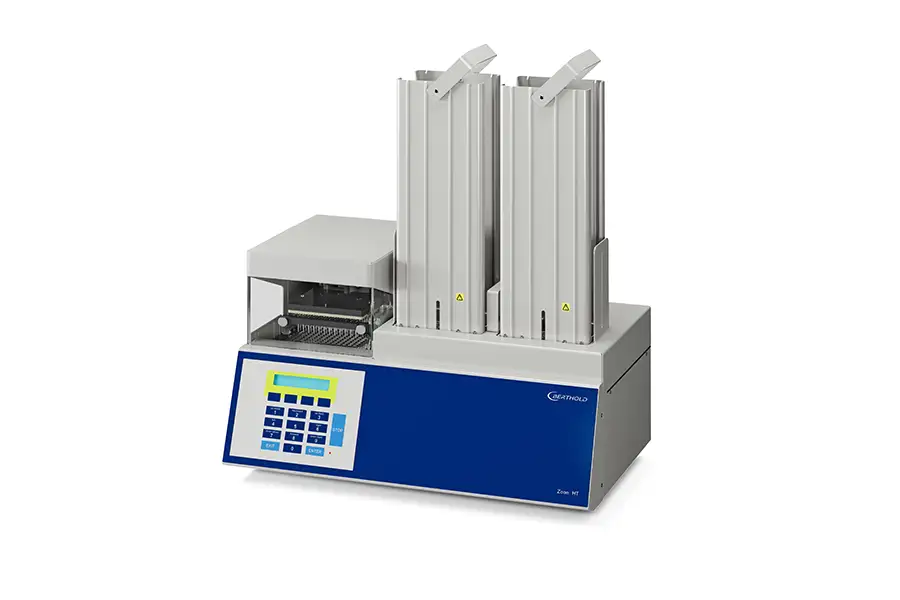
Description
Designed for high-throughput environments, the Zoom HT from Berthold Technologies is the most efficient 96- and 384-well microplate washer in its class. With unmatched speed, high reliability, and a scalable modular system, it significantly increases your productivity by automating the washing, loading, and optionally, dispensing processes.
- Execution speed: Triple wash of a 96-well plate in just 14.5 seconds, or 17 seconds with automatic loading. Up to 190 plates washed per hour, or 1,330 plates per day.
- Continuous and automated operation: Integrated stacker for smooth plate handling and automatic waste management system for uninterrupted workflows
- Versatile format compatibility:Single wash head compatible with both 96- and 384-well plates
- Efficiency:Ultra-low residual volume: <1 µL/well, gentle processing—ideal for sensitive cell-based assays (ELISA)
Optional: A 2-channel reagent dispenser can be added, transforming the Zoom HT into a high-performance coating system, perfect for plate preparation applications.
The Zoom HT is an essential asset for laboratories that demand throughput and result quality.
Applications
The Zoom HT microplate washer is perfectly suited for a wide range of laboratory applications, thanks to its precision, speed, and flexibility:
- ELISA: significant reduction in the number of wash cycles required. With residual volumes < 1 μL/well, assay reproducibility is greatly improved.
- Plate coating: with the 2-channel dispensing module, the Zoom HT enables automated workflows for coating and plate preparation, without manual intervention, for ready-to-use plates.
- Cell-based assays: gentle cell handling, reduction of background noise and experimental variations, resulting in better data quality and higher Z’ factors.
Automated Elisa Systems
ELISA Crocodile 5-in-1
Crocodile 5-in-one ELISA mini Workstation

Description
The Crocodile 5-in-1 ELISA mini workstation is a compact and fully automated solution for processing ELISA tests. It combines five essential functions into a single standalone device, saving time while ensuring reliable and reproducible results. Thanks to its small footprint, it fits perfectly in any laboratory, even those with limited space.
- Complete ELISA automation: replaces five separate instruments (dispenser, shaker, incubator, washer, reader) with a single integrated system
- Time-saving: eliminates manual plate transfers between steps; allows you to focus on other tasks during the analysis
- Small footprint: only 26.5 cm wide, with a total required space under 40 cm
- Flexible use: compatible with all 96-well plate assays; allows integration of manual steps in the protocol (e.g., placing/removing lids)
- Customizable optical filters: 4 standard preinstalled filters (405, 450, 492, 620 nm) + 4 available positions for specific filters
- Partial mode operation: each function can be activated independently to replace dedicated equipment (e.g., washer only or incubator only)
- Intuitive software: automatic generation of a comprehensive report including results, performed steps, start/end times, temperatures, and control parameters
- Standalone device: simply insert the plate and start the protocol, the Crocodile takes over without requiring continuous supervision
Applications
The Crocodile 5-in-1 workstation adapts to all types of ELISA tests across many fields of analysis:
- Veterinary diagnostics
- Food safety testing
- Clinical research
- Research and development (R&D) on immunoassays
- Quality control (QC) in regulated environments
Ideal for laboratories seeking a versatile, compact, and automated system, the Crocodile 5-in-1 optimizes efficiency without compromising precision.
Crocodile 4-in-1 Assay
Crocodile 4-in-1 Assay mini Workstation
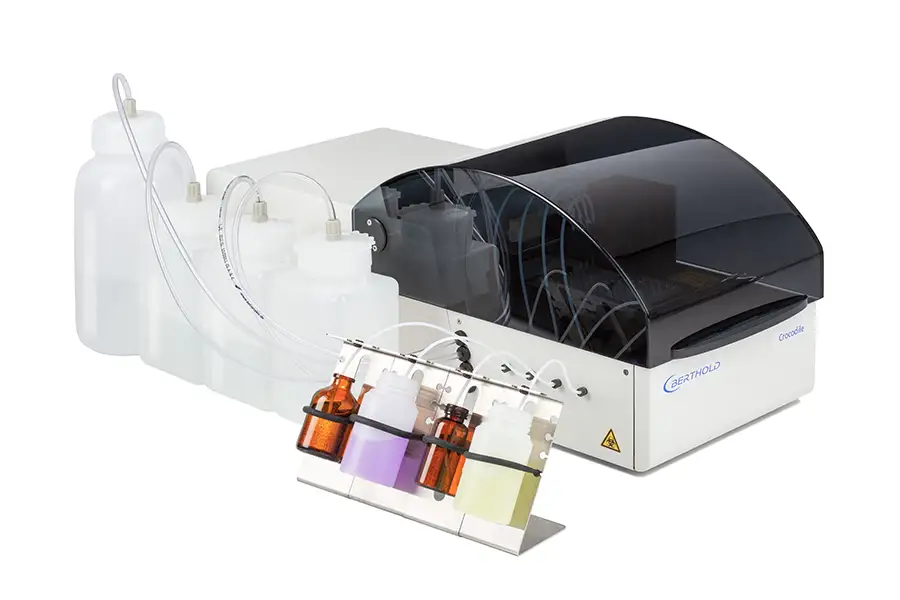
Description
The Crocodile 4-in-1 Assay is a compact and easy-to-use solution for automating microplate assays. It combines four essential functions into a single standalone device to optimize your laboratory workflow.
Thanks to its space-saving design, it fits perfectly into any environment, even the most confined, without compromising performance or reliability.
- Simplified automation of critical assay steps: DReagent dispensing, Shaking, Incubation, Plate washing
- Time-saving: éeliminates manual transfers between equipment; all operations take place within one device
- Standalone operation: simply insert the microplate, select the protocol, and the Crocodile runs the test without supervision
- Intuitive interface: customizable protocol with the possibility to integrate manual steps (e.g., adding/removing lids during incubation)
- Compact footprint: only 26.5 cm wide; with all bottles included, the total required space does not exceed 40 cm
- Versatility: compatible with all 96-well plate assays; modules can also be used individually (incubator or washer alone, for example)
- Génération automatique de rapports : le logiciel fournit un rapport complet incluant résultats, séquence des étapes, heures d’exécution, température et autres paramètres
- Scalability: option to upgrade the workstation with a compatible reader or choose the Crocodile 5-in-1 ELISA version with an integrated reading module.
Applications
In combination with a compatible reader, the Crocodile 4-in-1 Assay mini-workstation automates liquid handling and incubations for a wide range of applications in research, diagnostics, and quality control:
- ELISA tests
- Luminescence immunoassays (LIA / CLIA)
- Fluorescence immunoassays (FIA)
- DNA arrays and microarrays
- Protein and antigen arrays
- ELISpot
- Bead-based multiplex assays
Ideal for laboratories looking to save time, reduce manual errors, and efficiently automate critical protocol steps without investing in a high-throughput platform.
Microvolume Spectrophotometers
Colibri +
Ultra-fast, standalone microvolume spectrophotometer
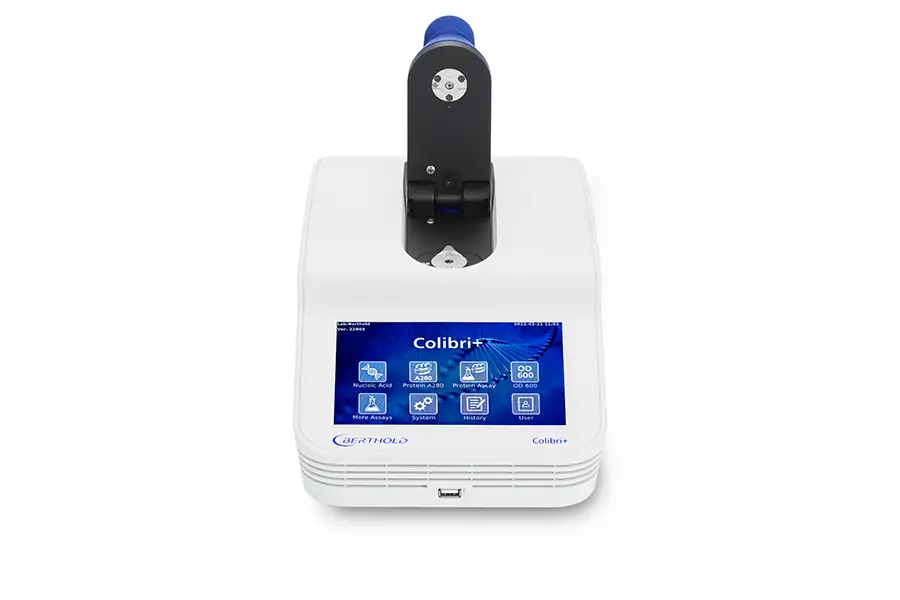
Description
The Colibri+ is a next-generation microvolume spectrophotometer designed to combine precision, speed, and ease of use. Ideal for demanding laboratories, it allows you to measure your samples in less than 3 seconds, with exceptional reproducibility (CV < 1%).
Main features:
- Ultra-fast measurement: obtain your results in under 3 seconds.
- Wide detection range: from 190 to 1000 nm, covering a broad variety of applications.
- Low volume analysis: precise measurement on volumes from 1 to 3 µl.
- High sensitivity: from 2 to 20,000 ng/µl for double-stranded DNA and from 0.06 to 600 mg/ml for proteins like BSA, no more tedious dilutions needed.
- Standalone mode: with 32 GB internal memory, no computer is required.
- 7” color touchscreen: intuitive interface with numerous preprogrammed protocols.
- Sample illumination guidance: faids pipetting even in low-light conditions
- Front USB port: easy and quick export of results.
The Colibri+ is the ideal solution for researchers looking to save time without compromising result quality. It integrates easily into any workflow in molecular biology, biochemistry, or biotechnology.
Applications
Are you working on real-time PCR, sequencing/NGS, or cloning projects? The Colibri+ spectrophotometer is the ideal tool to support your research, thanks to its compatibility with a wide range of applications:
- Determination of nucleic acid concentration and purity without dilution
- Analysis of purified proteins (A280)
- Bradford, BCA, and Lowry assays for protein quantification
- OD600 measurements for cell density
- General UV-VIS spectrophotometry
Colibri + C
Ultra-fast microvolume analysis
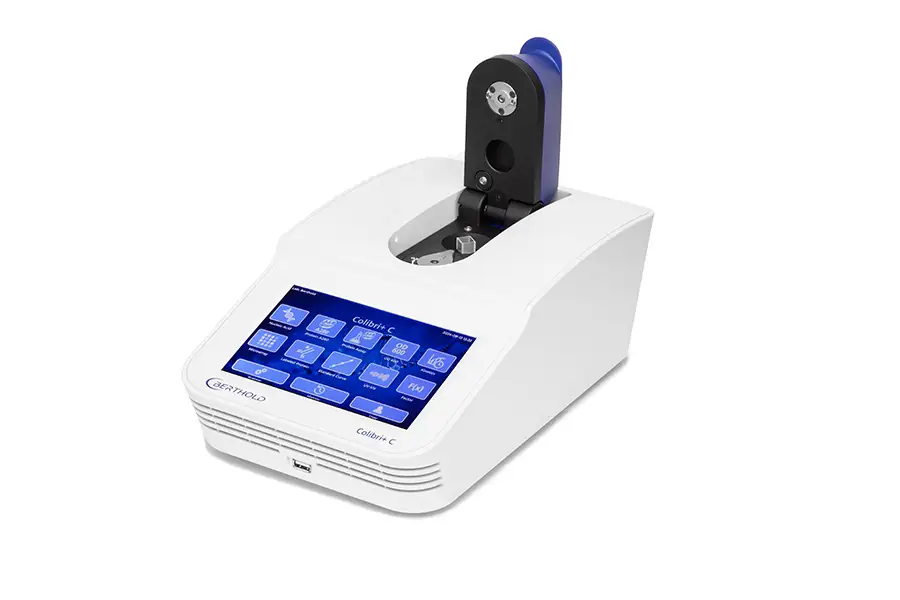
Description
The Colibri+ C combines ultra-fast microvolume analysis and cuvette option in a single compact instrument. Designed to simplify your workflow, it delivers precise results in under 3 seconds from volumes as low as 1 µL. Its large 7″ touchscreen, standalone operation, and support for kinetics make it a versatile and high-performance tool, perfect for molecular biology and biochemistry laboratories.
- Ultra-fast reading < 3 s for microvolumes
- Minimum required volume: 1 µL
- Wavelength range: 190–1000 nm
- Two microvolume optical path lengths (0.5 mm and 0.05 mm)
- Cuvette option: multiple path lengths, temperature control from 37 to 45 °C, and shaking
- Reliability: absorbance coefficient of variation < 1%
- 7″ touchscreen and standalone operation
- Connectivity options: USB-A and USB-B ports
- Compact unit: 206 × 333 × 166 mm, weight 3.5 kg
Applications
The Colibri+ C addresses a wide range of laboratory applications in a single device:
- Rapid quantification of DNA, RNA, and proteins (microvolume and cuvette)
- Nucleic acid purity analysis (A260/A280 and A260/A230 ratios)
- Colorimetric assays: Bradford, BCA, Lowry
- Protein quantification by A280
- Cell density tests (OD600)
- LKinetic readings via the cuvette option (temperature stimulation and maintenance)
- General UV-VIS spectrophotometry for molecular and cellular research
The Colibri+ C is the ideal solution for researchers seeking to combine speed, versatility, and precision, with the benefit of an all-in-one system for both microvolume and cuvette measurements.
Tube Luminometer
Sirius 2
Ultra-Sensitive Tube Luminometer
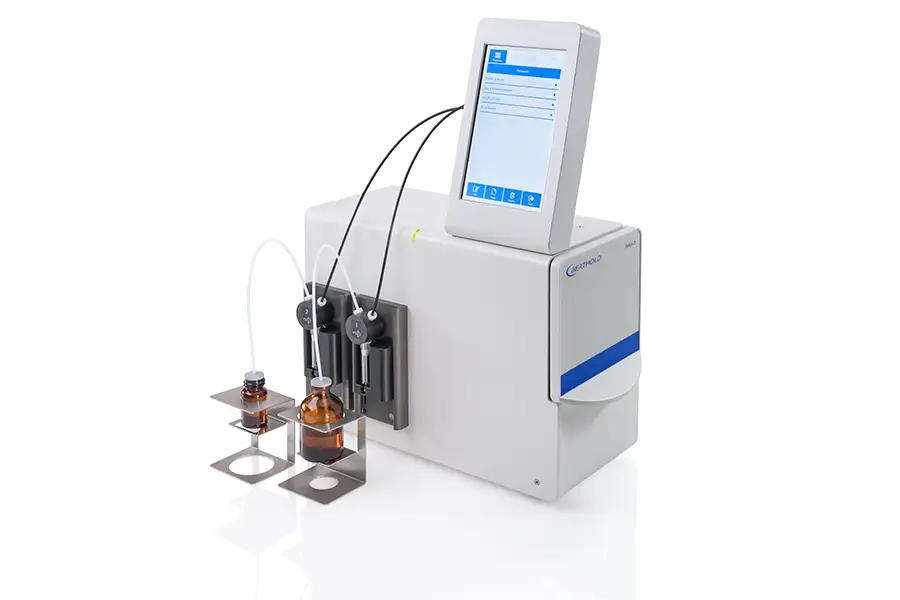
Description
Designed for laboratories seeking a compact and high-performance solution, the Sirius 2 is a tube luminometer offering extremely sensitive detection and remarkable flexibility. Its intuitive and modular design makes it a powerful tool for Glow, Flash, chemiluminescence, and bioluminescence analyses..
- Ultra-sensitive detection: ≤ 0.5 zmol luciferase (≈ 1 amol ATP/tube), thanks to an optimized detection window and a low-noise photon-counting photomultiplier
- CCompact and ergonomic: sturdy sample drawer and small device size (34 × 15 × 24 cm)
- Multiple compatible formats: 12 mm tubes (55/75 mm) and microtubes (1.5–2 mL), with interchangeable holders.
- Injector option: up to 2 automatic syringes (20–500 µL) for Flash assays requiring reagent addition
- Automatic start: measurement begins immediately once the drawer is closed
- Intuitive interface: available with a 7″ touchscreen or PC connection, including duplicate management, graphical displays, and advanced functions.
- Easy data export: CSV, Excel, PDF, HTML formats; printing capabilities.
Applications
The Sirius 2 is suited for a wide range of tube-based luminescence analyses, including:
- Reporter gene assays (single and dual luciferase)
- Luminescent immunoassays (luminescence ELISA, CLIA)
- QATP quantification for cell viability or cell concentration
- Caspase assays for reliable apoptosis detection
- Kinase tests via enzymatic luminescence
- Toxicity and mutagenicity analyses of water samples
- Auto-injected Flash kinetic assays
The Sirius 2 combines sensitivity, speed, and flexibility in a compact format that is easy to integrate on any workspace. It is ideal for medical, research, environmental, or industrial laboratories seeking reliable measurements without compromise.
Lumat
High-Performance Tube Luminometer
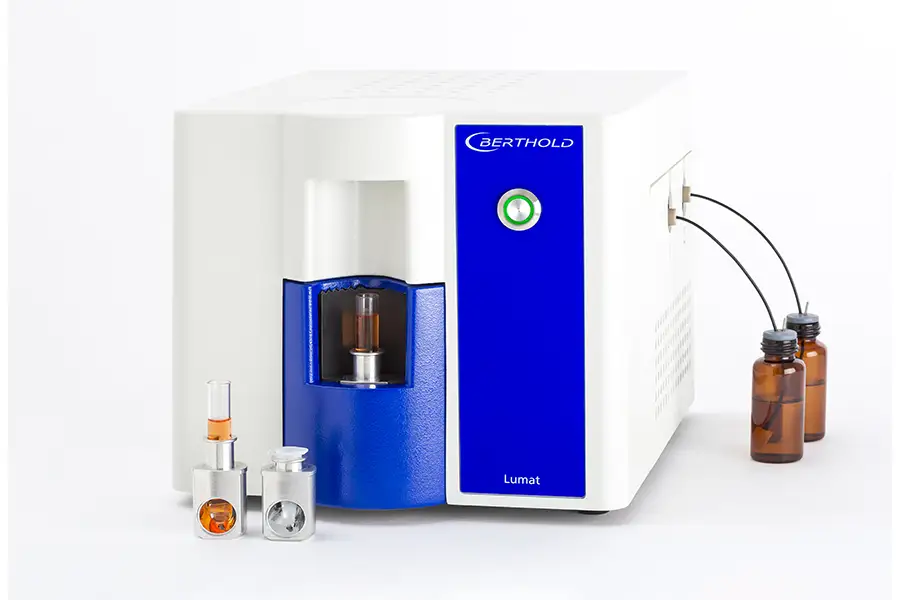
Description
The Lumat is a tube luminometer combining extreme sensitivity, a wide dynamic range, and ease of use. Designed for Flash, Glow, chemiluminescence, and bioluminescence measurements, it perfectly meets the needs of research and diagnostic laboratories.
- Ultra-sensitive detection: < 1 zmol luciferase and < 1 amol ATP per tube (high sensitivity model)
- Wide dynamic range: ≥ 6 orders of magnitude, thanks to photon counting technology and a low-noise photomultiplier tube (PMT)
- Integrated JET injectors: up to 2 automatic syringes (0.1–300 µL) for fast, precise (< 2%) kinetic measurements that are cell-friendly
- Smooth sample changeover: motorized turret enabling preparation of one tube while analyzing another
- LightCompass® software: flexible protocols, graphical analysis, curve adjustments, and FDA 21 CFR Part 11 compliance
- Compatible formats: luminescent tubes 12 × 47/55/75 mm and microtubes 1–2 mL
- PC USB interface: Windows operation, data export, printing, and full report generation
Applications
The Lumat is suitable for a wide range of luminescence analyses in fields such as biology, pharmacology, and more, including:
- Reporter gene assays (single or dual-luciferase)
- Luminescent immunoassays (LIA, ILMA, CLIA)
- ATP assays to assess microbial viability or purity
- Enzymatic activity assays (kinases, caspases)
- Environmental toxicity testing (water, industrial effluents)
- DNA probe tests in chemo- or bioluminescence
- Flash kinetic measurements with JET injectors
The Lumat combines maximum sensitivity, flexibility, and user comfort to meet all your luminescence analysis needs on tubes.
Junior
Portable Tube Luminometer
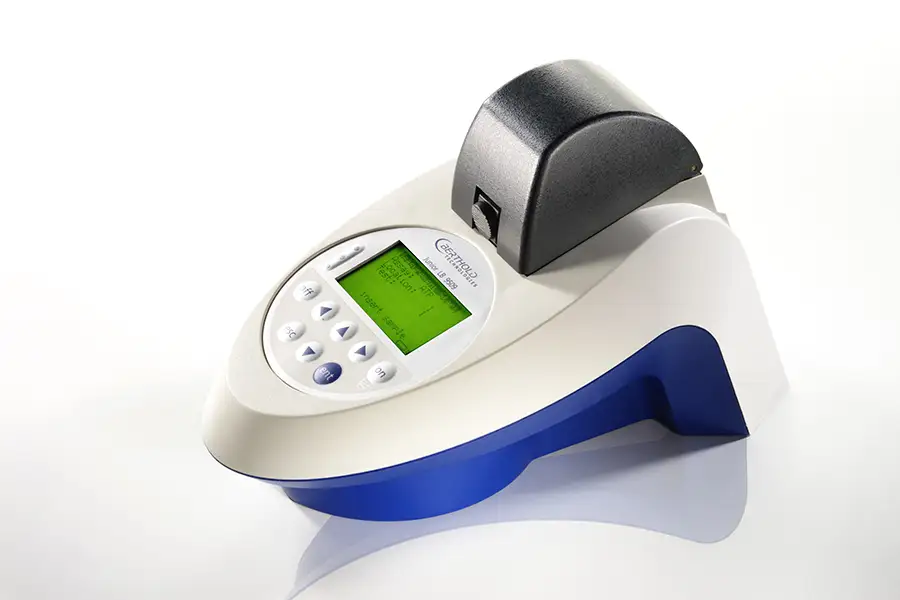
Description
The Junior is a portable and high-performance tube luminometer, ideal for Glow and chemiluminescence measurements anywhere—whether in the lab, in the field, or outdoors. Compact, lightweight, and autonomous, it delivers measurement quality equivalent to a benchtop device.
- High sensitivity: detects less than 1 fmol ATP/tube in the standard version, and down to 50 amol ATP/tube in the high-sensitivity version
- Wide dynamic range: pover 6 orders of magnitude, allowing detection from very low to very high signals
- Low-noise photon-counting photomultiplier for optimal signal-to-noise ratio
- Battery-powered autonomy: several hours of use without cables, rechargeable from mains power
- Compatible with multiple formats: luminescent tubes 12×47/55/75 mm, microtubes 1/1.5/2 mL, capped 4 mL vials
- Built-in interface: simplified navigation via membrane keypad and LED graphical display (3 indicators: red, yellow, green)
- Internal memory: stores the last 2,000 measurements, sortable by date or sample number
- PC connection: data transfer via WinTerm software (CSV/Excel)
- Compact size: only 2 kg for 150 × 280 × 170 mm – supplied with a carrying case.
Applications
The Junior is designed for a variety of uses both on the move and in the laboratory:
- ATP quantification (viability, biomass, industrial hygiene)
- Hygienic monitoring of surfaces and equipment in medical or industrial settings
- Reporter gene assays (luciférase, etc.)
- Clinical and research luminescent immunoassays
- Mycoplasma detection and cell culture monitoring
- Toxicity and mutagenicity analysis of environmental samples (water, etc.)
- On-site measurements for biotechnology, process control, or environmental monitoring
The Junior stands out as the ideal portable solution for reliable luminescence analyses, combining mobility, sensitivity, autonomy, and ease of use.
In Vivo Imaging System
NightSHADE evo
In Vivo Imaging System
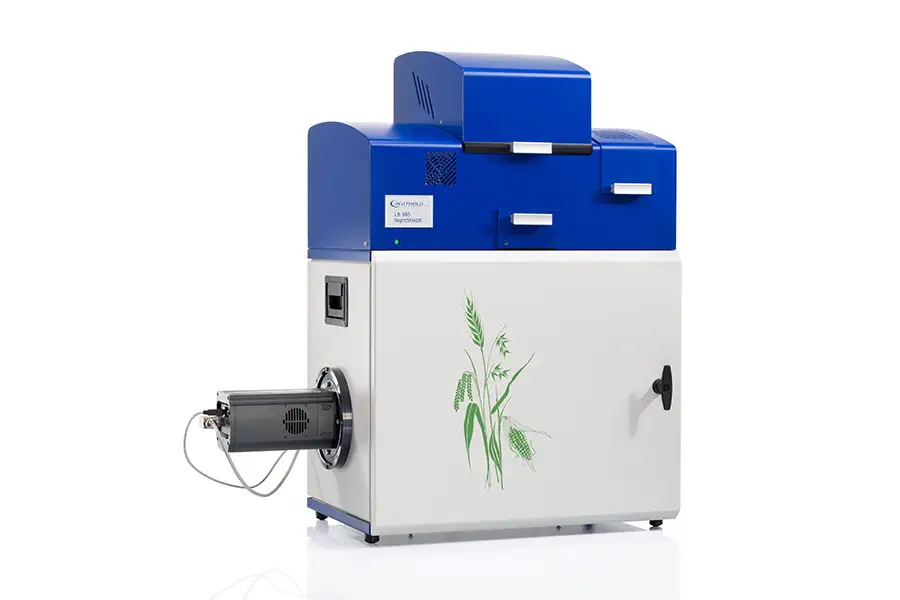
Description
The NightSHADE evo is a modular, high-performance, and user-friendly optical imaging system designed for in vivo analysis. Featuring a dark chamber equipped with a deeply cooled CCD camera, it enables simultaneous observation of luminescence and fluorescence in tissues, shoots, and whole plants with exceptional sensitivity.
- Ultra-sensitive back-illuminated CCD camera covering the visible and near-infrared spectrum, cooled down to −100 °C to minimize background noise
- Flexible camera mounting: top or side imaging options for optimal monitoring of vertical seedlings
- Modular opaque chamber awith access ports for fiber optics, light guides, or internal irrigation
- Environmental condition simulation: controlled temperature (15–30 °C), daylight simulation with two quad-color LED panels, adjustable humidity
- Optical modularity: choice of illuminators (ring, flexible, flood) and adapted sample holders (boxes, Petri dishes)
- Powerful and intuitive indiGO™ software: excitation/emission filter management, LED control, multi-wavelength acquisition, real-time analysis.
Applications
The NightSHADE evo offers a wide range of in vivo imaging applications:
- Imaging of luminescence and fluorescence in tissues, seedlings, and whole plants
- Monitoring of circadian rhythms through prolonged acquisitions under controlled conditions
- Real-time mapping of gene expression from germination to adult plants, without distortion due to geotropism
- Monitoring biotic and abiotic stress: detection of responses to pathogens, drought, herbicides via delayed fluorescence
- Visualization of protein-protein interactions through fluorescent tagging on seedlings or young plants
- Phenotypic and pathogenic screening son multiple Petri dishes using multi-position holders and automated acquisition
The NightSHADE evo is the ideal solution for plant research laboratories seeking sensitivity, flexibility, and environmental control for rigorous and informative in vivo studies.
Need a quote or a specific request??
Even
a protein
needs
to express
its potential.
Cell-Free Systems Applications
